Trumai
- Self-denomination
- Where they are How many
- MT 260 (Siasi/Sesai, 2020)
- Linguistic family
- Trumái
The Trumai are considered to be one of the last groups to have arrived in the area of the upper Xingu River, in the first half of the 19th Century. They inhabit the central region of the Indigenous Park of the Xingu, a region adjacent to the cultural complex known as the Upper Xingu, whose peoples, despite their linguistic differences, share a series of cultural characteristics and are articulated in a network of specializations in trade and intersocietal rituals. The Trumai, for their part, feel that they are on the margins of this system, not being recognized by, nor they recognizing themselves as absolutely integrated into it. Nevertheless, they end up being influenced by, and influencing a series of upper Xingu customs related to rituals, material culture and productive activities.
Location
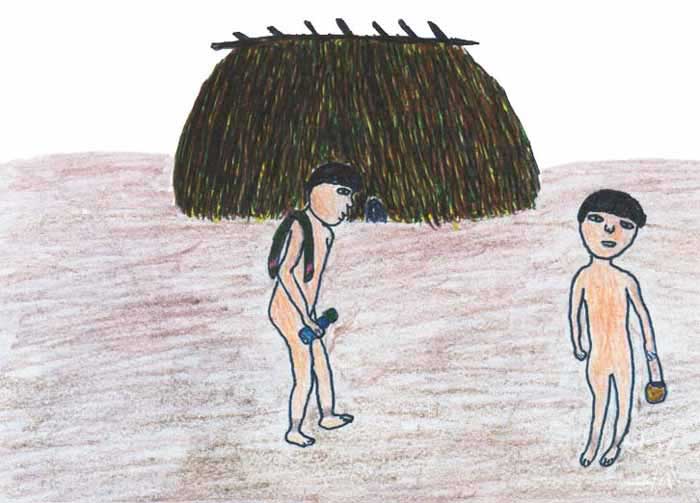
Inhabitants of the Indigenous Park of the Xingu, the Trumai are distributed in four main villages: Terra Preta, Boa Esperança, Steinen and Terra Nova. These villages are situated halfway between the Leonardo Villas-Bôas Post and the Diauarum Indigenous Post. There are also families living at these posts and in the cities of Canarana (three families) and Feliz Natal (one).
Population

The Trumai were quite numerous at the time they arrived in the Xingu, in the mid-19th Century. However, conflicts and wars with other peoples caused numerous losses, reducing the number of inhabitants in the villages. Later, the situation grew worse with the advent of flu and measles epidemics, which decimated whole families. The wars and the epidemics caused such depopulation of the Trumai that the group came to be considered on the verge of extinction.
Estimates indicate that in 1938, for example, there were 43 Trumai; in 1953, 25; in 1966, 26. Later, they managed to recover thanks to marriages with people from other ethnic groups and an increase in fertility.
The group continues growing and has a total of 120 individuals; however, their dispersion over the last few years is having negative effects on the continuation of their ethnic identity. There are few elderly men and women and the Trumai show their resentment at the lack of a chief who exercises leadership, dominates ritual knowledge and promotes festivals, stimulating union among the villages. As they say themselves, although scattered they still consider themselves as a single people, wishful of maintaining their traditions and knowledge.
Name
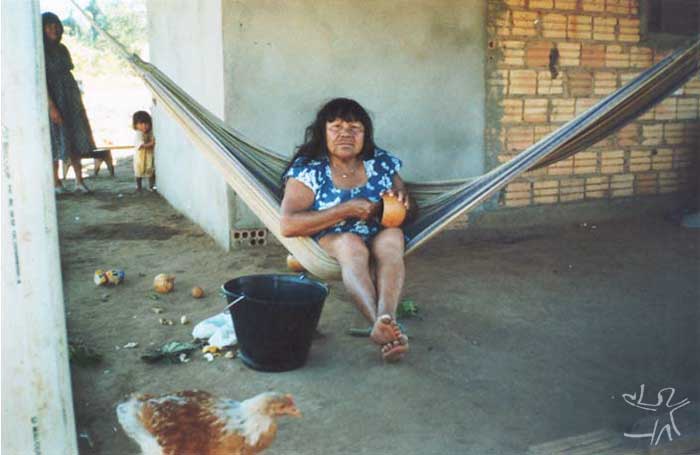
It is debatable whether the term Trumai is the original, ancient self-designation, or whether it was attributed to them by another indigenous group, and later became widely used as a result of its acceptance in common use among the Trumai themselves. The term itself does not fit the phonological patterns of the language, which does not have words with the sequence of sounds tr. Even the borrowings from Portuguese which have junctures of consonants of this type tend to have a vowel inserted between the two consonants (for example: [pa´ratu] prato). This pattern leads us to suppose that the term Trumai may have come from another group, probably non-Xinguan. On the other hand, it is also possible to speculate that it may really have originated from this language, being just a shorter version of an earlier form that had a vowel between [t] and [r], which was later omitted (perhaps tyrumai). This hypothesis is not out of the question, given that the same sort of thing occurs with the name of one of the ancient Trumai villages, which has two ways of pronouncing it: Karajajan and Krajajan. Nevertheless, the lack of greater evidence limits us to the terrain of speculation.
When consulted about the subject, several Trumai today say only that there existed in the past another term used by the group as ethnonym, but there are disagreements over this. According to several people, the ancient term used by the group was ho kod-ke, which meant "the archers, those who had arrows of waxpoint", referring to the fact that these people were the owners of the Jawari festival, which they introduced to the Upper Xingu. According to others, if this was the meaning being expressed, then the name of the Trumai would have been hid kod-ke, because ho kod ke can be translated as "those with a short round-shaped penis". Several Trumai say that the term ho kod ke was used just as a nickname for the group, referring to the fact that in the past, Trumai men tied up their penises, which gave them a certain rounded shape. Thus, seemingly, the term ho kod ke did in fact exist, and is confirmed by several people, but not as a name used for collective self-reference in formal or cerimonial situations.
Language
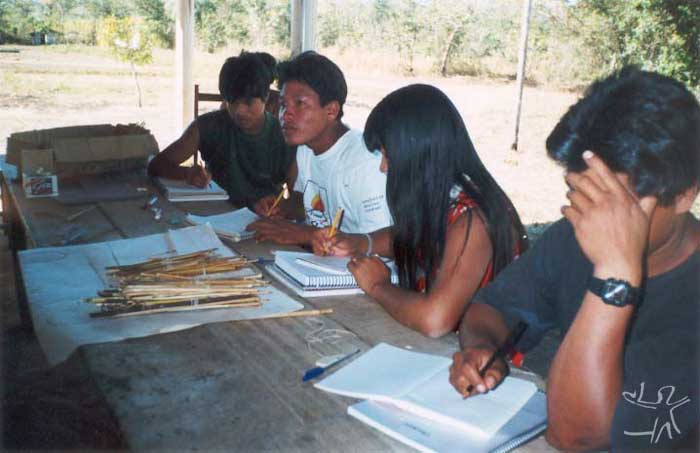
The Trumai language is considered isolated, that is, it does not show genetic kinship with any other language of the Xingu nor with other known linguistic families. The present situation of the Trumai language is quite delicate, for there are few speakers and unfortunately the children are no longer learning to speak the language in daily life, which means that there is a great risk that it may come to disappear. Most of the Trumai children speak Aweti, Suyá or Portuguese as a first language.
The fact that the speakers live dispersed in different places produces even greater complications, for contact among them - and consequently, the use of the Trumai language - is becoming more and more reduced. Several efforts are being made to change the present situation, notably educational work of indigenous teachers. Through their classes, they try to stimulate the younger generation to go back to using Trumai in their daily activities. The teachers have also organized a book, which was published in 2002, with the assessment of the ISA staff for teaching the Trumai language as a second language. But this is a long-term work, which requires not only the efforts of the teachers but also the participation of the community as a whole.
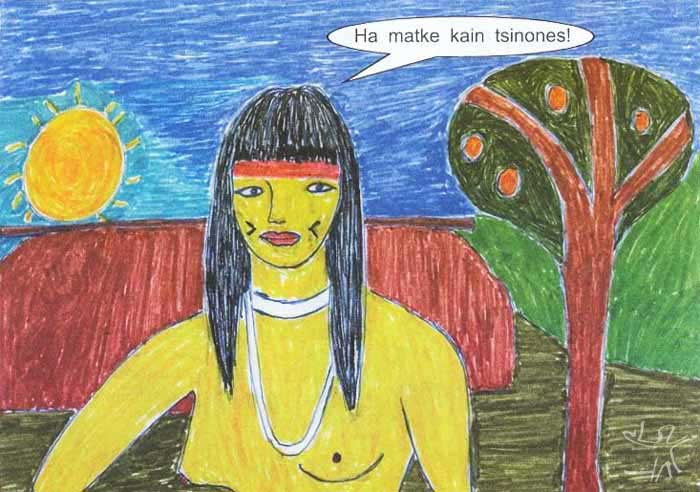
Analyzing the vocabulary of the Trumai language, one can verify the presence of several borrowings from Kamayurá, which can be explained by the fact that perhaps Kamayura was a lingua franca on the upper Xingu, a means of communication between linguistically distinct groups. More probable, however, is that the strong influence of the Kamayurá language on Trumai occured as a result of interethnic marriages.
In relation to more recent cultural changes, one can also observe the presence of various borrowings from Portuguese to name objects introduced by the whites: aros ("arroz", rice), asuka ("açúcar", sugar), kopu ("copo", cup), motó ("barco a motor", motorboat). In some cases, the borrowing from Portuuguese could be expressed as a neologism in Trumai. For example, kopeta ("coberta", covered) or mape kwach ("instrumento de cobrir", covering instrument), kafe ("café", coffee) or su dat´-ke ("suco que é preto", juice that is black).
History of their occupation in the Xingu
The history of the Trumai is rather uneven, at least what we know from the written sources. The group came from a region between the Araguaia and the Xingu, having left as a result of attacks from another people, probably the Xavante. It is probable that they arrived in the Xingu in the first half of the 19th Century. By occupying the territory between the headwaters of the Xingu River and the region of the banks of this river, the Trumai suffered repeated attacks from groups that inhabited these areas, such as the Suyá and the Ikpeng. The ethnographer Karl Von den Steinen encountered them already quite debilitated in 1884.
In contact with the peoples of the upper Xingu, the Trumai eventually were integrated into the trade networks as suppliers of stones used in the making of axes. Over a long period of living together, they absorbed fundamental elements of the upper Xinguan culture, despite their never being seen nor seeing themselves as "different".
Until the 1950s, the Trumai made moves within the limits of their territory (in the region of the lower Kuluene River) or sought protection in the villages of neighboring groups. Later they moved away from this area towards the proximities of the Diauarum Indigenous Post, because of epidemics of measles and flu which they suffered during this period.
Since 1968, they have a village in the proximities of the Leonardo Villas-Bôas Post, relatively near their traditional places. Having passed a phase of demographic and social recovery - which also occured with other groups of the Park - a new village emerged to the north of the junction of the formative rivers of the Xingu, at a place called Malakafiá. Another village emerged several years later in Wara'i (or Awarai), where these people had lived long ago. In this period, part of the territory inhabited until the 1950s and 60s had already been occupied by other upper Xinguan groups or was used for the installation of the airbase of Jacaré. The Trumai, however, periodically visit their old gardens and sites, such that the stretch of the Xingu between the Leonardo and the Diauarum posts is an area that is widely crossed and exploited by them.
The Trumai and the Upper Xingu
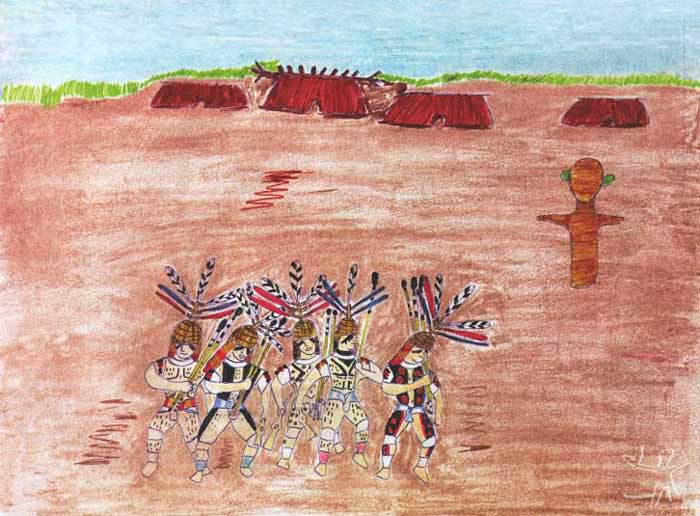
Before migrating to the Xingu, the Trumai say that they slept on mats (weset); they utilized the arrow propeller and (hopep) and the club (nai)as weapons. The men tied up their penises with embira and wore their hair long; the women used a band around the waist which passed between their legs (which was called tsapakuru and was made of desnit, a type of embira). After their arrival on the upper Xingu, the Trumai began to incorporate habits which were common to the peoples of the area, such as the use of bows and arrows and sleeping in hammocks. The term used for hammock is a neologism which probably was coined after they had contact with this object: esa-'k ("that which dances"), referring to the fact that the hammock "dances" when it swings back and forth. The women substituted the traditional band for the uluri belt (or g-string) and the men began to cut their hair and adorn their bodies in the same way as the other upper Xingu peoples. They also incorporated various aspects of mythology and local festivities and, at the same time, they taught several of their traditions to other groups. For example, it was the Trumai who brought to the Xingu the Jawari and Tawarawan' festivals.
Although they have incroporated various upper Xingu cultural patterns, the Trumai preserve certain peculiarities which still differentiate them from the other peoples of this area. For example, they usually don't participate in the Kwarup and consume foods which are prohibited to the upper Xinguans, such as capybara and coati. Other peoples of the region see this custom as proof of the aggressive character of the Trumai.
Besides this, in the songs of the Jawari ritual, there is a notable presence of various game animals, such as the jaguar, wildcat, monkeys, etc. In Trumai zoological taxonomy, the world of the animals is divided into two groups: those "of the air" - mammals and birds: kodetl - and those of the water - the fish: k´ate. In most of the Jawari songs, birds, felines, and various mammals "sing" in their own name, which characterizes a society that is traditionally focused on hunting and not fishing. In contrast, the Kwarup of the peoples of the upper Xingu monopolizes the entities of the waters, particularly in body painting.
The specialization of the Trumai at the moment of their entrance to the upper Xingu seems to have been the production of salt (jakyr) out of aquatic leaves and a monopoly over the supply of stone axes (daka), either through the making of these axes, or through the deposit for extraction of the materials used in their making. However, the stone axes were later substituted for metal axes. The Trumai were also suppliers of cotton, pequi fruit and pequi oil.
Rituals
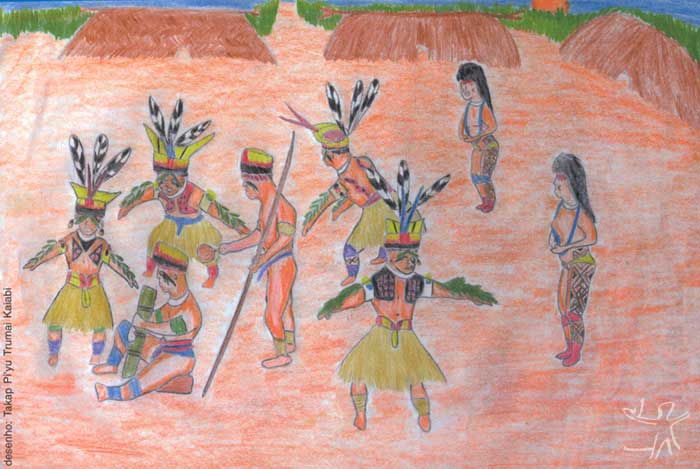
The Trumai are given credit for introducing two cerimonial cycles in the upper Xingu: the Jawari and the Tawarawan'. Even when they had intense contact with the peoples of the upper Xingu, for a long time the Trumai did not participate in the Kwarup cerimonies. It is said that, in the first Kwarup in which they were present, the ritual posts became alive and held on to them with violence. After that time, they did not want to participate in the festival anymore. In 1966, however, the Trumai chief Nituary sang at the Kwarup for Leonardo Villas-Bôas, a celebration which brought together all the peoples of the upper Xingu.
The Jawari is a ritual dedicated to the dead warriors, the central event of which is the dart throwing contest using a dart-propeller, in the midst of an extensive set of songs and episodes of polemic dialogues. The Jawari brings together symbols of war and peace; at the same time it constructs the space for double alliance with enemies and with women.
The Tawarawan', in turn, is a happy festival, in which the men dance in the morning decorated with buriti straw fibre and banana leaves, feather crowns and leaves of a sweet-smelling tree (rikáda xudak) on their arms and covering their faces. The women are painted and dance on foot, alone, following the steps of the men. Later, they dance hanging on to the point of the men's straw skirt and then they dance in circles with the men. There are two musicians and singers who remain seated, one of them shaking a rattle and the other beating a kind of wooden drum.
Sources of information
- BECQUELIN, A. Monod. Le guerrier et l'oiseau : mythe et rite du Javari chez les Trumai, Haut Xingu. Bulletin de la Soc. Suisse des Américanistes, Genebra : Soc. Suisse des Américanistes, n. 57/58, p. 97-122, 1995.
- --------. O homem apresentado ou as pinturas corporais dos índios Trumaís. In: COELHO, Vera Penteado (Org.). Karl von den Steinen : um século de antropologia no Xingu. São Paulo : Edusp/Fapesp, 1993. p. 511-61.
- FERREIRA, Mariana Kawall Leal (Org.). Histórias do Xingu : coletânea de depoimentos dos índios Suyá, Kayabi, Juruna, Trumai, Txucarramãe e Txicão. São Paulo : USP-NHII/Fapesp, 1994. 240 p.
- FRANCHETTO, Bruna. Laudo antropológico : a ocupação indígena da região dos formadores e do alto curso do rio Xingu. Rio de Janeiro : s.ed., 1987. 159 p.
- GALVÃO, Eduardo. Diários do Xingu (1947-1967). In: GONÇALVES, Marco Antônio Teixeira (Org.). Diários de campo de Eduardo Galvão : Tenetehara, Kaioa e índios do Xingu. Rio de Janeiro : UFRJ, 1996. p. 249-381.
- GUIRARDELLO, Raquel. Uma abordagem preliminar da etnografia da comunicação na comunidade Trumai, Parque Xingu. In: SEKI, L. (ed.). Lingüistica indígena e educação na America Látina. Campinas : Unicamp, 1993. p. 351-363.
- --------. Aspectos da morfossintaxe da língua trumai (isolada) e de seu sistema de marcação de caso. Campinas : Unicamp, 1992. 200 p. (Dissertação de Mestrado)
- --------. A reference grammar of Trumai. Houston : Rice University, 1999. 452 p. (Tese de Doutorado)
- LEA, Vanessa R. Laudo histórico-antropológico relativo ao Processo 00.0003594-7 - Ação Originaria de Reivindicação Indenizatória na 3ª Vara da Justiça Federal do Mato Grosso. São Paulo : s.ed., 1994. 130 p. (AI: Parque Indígena do Xingu)
- MONOD-BECQUELIN, Aurore. Le guerrier et l’oiseau : mythe et rite du javari chez les Trumai, Haut Xingù. Bulletin de la Société suisse des Américanistes, Paris, n.57/58, p.97-122, 1996.
- --------. Histoire de soleil et lune et autres mythes trumai. Paris : Selaf, 1975.
- --------. O homem apresentado ou as pinturas corporais dos índios Trumaís. In: COELHO, Vera Penteado (ed.). Karl von den Steinen : um século de antropologia no Xingu. São Paulo : Edusp, 1993. p. 511-62.
- --------. L’ici et l’ailleurs : Ethnographie de la frontière chez les Trumai. s.n.t. 36 p.
- --------. Multilinguisme des indiens Trumai (Brésil Central). Language, Paris, n. 18, p. 78-94, 1970.
- --------. Le pratique linguistique des Indiens Trumai (Haut Xingu, Mato Grosso, Brésil). 2 v. Paris : SELAF, 1975.
- --------; GUIRARDELLO, Raquel. História Trumai. In: FRANCHETTO, Bruna; HECKENBERGER, Michael J. (Orgs.). Os povos do Alto Xingu. Rio de Janeiro : UFRJ, 2001. p. 401-43.
- MURPHY, Robert F.; QUAIN, Buell. The Trumai indians of Central Brazil. Seattle : University of Washington Press, 1966. (Monographs of the American Ethnological Society, 24).
- PADILHA, Solange. Amatiwana Trumai : universo e pintura. São Paulo : PUC, 2001. 225 p. (Tese de Doutorado)
- SUTHERLAND LOUIS, Ann. Alliance and descent : the Trumai Indians of central Brazil. Man, s.l. : s.ed., v. 6, n.1, p.18-29, 1971.
- TRONCARELLI, Maria Cristina (Org.). Trumai. São Paulo : ISA, 2002. 120 p.
VIDEOS